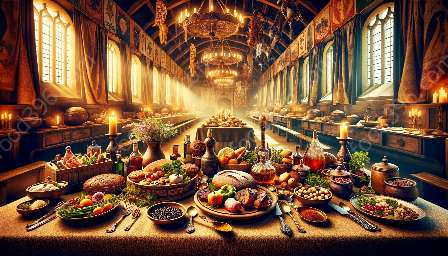The Middle Ages was a significant period for the development of culinary tools and equipment that had a profound impact on the history of cuisine. During this time, various factors such as technological advancements, trade, and cultural exchanges influenced the evolution of cooking tools and techniques. Let's explore the fascinating journey of culinary tools and equipment during the Middle Ages and their impact on the history of medieval cuisine.
Overview of Medieval Cuisine History
Medieval cuisine history encompasses the culinary practices and food culture of Europe during the Middle Ages, roughly spanning from the 5th to the 15th century. The period was marked by significant changes in agricultural practices, trade routes, and the introduction of new culinary ingredients and techniques. The cuisine of the Middle Ages was shaped by the availability of ingredients, religious beliefs, social hierarchy, and technological innovations.
Evolution of Culinary Tools and Equipment
The evolution of culinary tools and equipment during the Middle Ages was closely intertwined with advancements in cooking techniques, the availability of ingredients, and the cultural influences of different regions. The following are some key aspects that contributed to the development of culinary tools and equipment during this period:
Technological Advancements
During the Middle Ages, there were notable advancements in metallurgy and blacksmithing, which led to the production of more refined and durable cooking implements. Iron, copper, and brass were commonly used to craft cooking pots, pans, and utensils. The ability to mold and shape metal allowed for the creation of specialized tools such as cauldrons, spits for roasting, and various types of knives and cleavers.
Influence of Trade and Cultural Exchanges
The medieval period was characterized by trade routes that connected different cultures, leading to the exchange of culinary techniques, ingredients, and cooking utensils. For example, the Silk Road facilitated the movement of spices, condiments, and exotic ingredients from the Far East to Europe, influencing the types of tools and equipment used in medieval kitchens. Additionally, the Crusades and other military campaigns introduced European kitchens to new cooking vessels, such as ceramic and earthenware pots, which were commonly used in the Middle East and North Africa.
Impact on Cooking Techniques
The evolution of culinary tools and equipment during the Middle Ages had a direct impact on cooking techniques. The introduction of enclosed brick ovens allowed for more efficient baking, while the use of spit-roasting mechanisms improved the process of cooking large cuts of meat. The availability of refined cutting tools also led to the development of more intricate food presentations and culinary decorations, reflecting the growing sophistication of medieval cuisine.
Notable Culinary Tools and Equipment
Several notable culinary tools and equipment emerged during the Middle Ages, shaping the way food was prepared and served. Some of these include:
- Spits and Roasting Implements: The use of rotisseries and spits for roasting meat became widespread during the Middle Ages, allowing for even cooking and the use of various spices and herbs for flavoring.
- Cooking Utensils: The availability of iron and copper resulted in the production of a wide range of cooking utensils, including saucepans, skillets, ladles, and sieves.
- Bakeware and Ovens: Brick ovens and various types of bakeware, such as pie molds, tart pans, and bread molds, became essential for baking bread, pastries, and pies.
- Cutting and Carving Tools: Knives, cleavers, and specialized cutting tools allowed for precise butchery and the presentation of elaborately carved meat and vegetable dishes.
- Serveware and Tableware: The Middle Ages saw the production of decorative tableware, including pewter, brass, and silver serving dishes, as well as intricately designed goblets, plates, and platters.
Legacy and Influence
The evolution of culinary tools and equipment during the Middle Ages laid the foundation for subsequent developments in the culinary world. The innovations of this period not only shaped medieval cuisine but also influenced cooking techniques and equipment in the centuries that followed. Many of the tools and utensils from the Middle Ages, such as copper cookware and hand-forged knives, continue to be prized by modern-day chefs and culinary enthusiasts for their durability and craftsmanship.
Overall, the evolution of culinary tools and equipment during the Middle Ages is a testament to the ingenuity and resourcefulness of medieval cooks and craftsmen. Their creations continue to inspire and inform the culinary practices of today, reminding us of the enduring impact of historical culinary developments on our modern gastronomic experiences.

